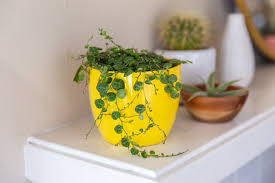In the realm of succulent enthusiasts, one plant that often catches the eye with its unique appearance and charming name is the "String of Turtles" (Peperomia prostrata). With its cascading vines adorned with tiny turtle-shaped leaves, this plant adds a whimsical touch to any indoor garden. In this comprehensive guide, we will delve into the world of String of Turtles, exploring its care requirements, propagation methods, flowering habits, and more.

String of Turtles Plant Overview:
The String of Turtles plant, also known as the Turtle Vine or Prostrate Peperomia, is a member of the Peperomia genus. Native to Brazil, this succulent is prized for its trailing stems that can reach lengths of up to 12 inches (30 cm) or more. Each stem is adorned with small, round leaves that resemble miniature turtles, hence its charming moniker.
String of Turtles Care:
Providing the ideal care conditions is essential for the health and vibrancy of your String of Turtles plant. Here are some key care tips to keep in mind:
-
Light: String of Turtles thrives in bright, indirect light. Avoid placing it in direct sunlight, as this can scorch the delicate foliage. A north or east-facing window is ideal for moderate light exposure.
-
Watering: As with most succulents, it's crucial not to overwater the String of Turtles. Allow the soil to dry out between waterings, and water sparingly during the winter months when growth slows down. Always use well-draining soil to prevent root rot.
-
Temperature and Humidity: String of Turtles prefers average to warm temperatures ranging from 60-80°F (15-27°C). It can tolerate lower humidity levels, but occasional misting or placing a humidifier nearby can benefit its overall health, especially in dry indoor environments.
-
Soil: Use a well-draining potting mix specifically formulated for succulents or cacti. A blend of perlite, sand, and peat moss works well to provide the necessary drainage while retaining some moisture.
-
Fertilization: Feed your String of Turtles plant with a balanced liquid fertilizer diluted to half strength during the growing season (spring and summer). Avoid fertilizing during the winter months when growth slows down.
String of Turtles Flowering:
While the primary allure of the String of Turtles lies in its charming foliage rather than its flowers, it does produce small, inconspicuous flower spikes under the right conditions. These tiny white flowers may appear in late spring or summer, adding a subtle touch of beauty to the trailing vines.
Propagation of String of Turtles:
Propagation of the String of Turtles succulent is relatively straightforward and can be achieved through several methods:
-
Stem Cuttings: Simply take a healthy stem cutting with at least a few leaves attached and allow it to callous over for a day or two. Plant the cutting in a small pot filled with well-draining soil and keep it lightly moist until roots develop.
-
Leaf Cuttings: Gently remove a leaf from the stem and allow it to callous over before placing it on top of moist soil. Keep the soil lightly moist until roots form, and a new plantlet emerges from the base of the leaf.
-
Division: If your String of Turtles plant has multiple stems, you can carefully divide the plant by separating the stems and planting them individually in pots.
Variegated String of Turtles:
Variegated varieties of the String of Turtles succulent are also available, featuring leaves with striking patterns of green and creamy white. These variegated specimens add an extra layer of visual interest to your indoor garden and require the same care as their non-variegated counterparts.
Is String of Turtles Pet Safe?
String of Turtles plants are considered pet-safe, meaning they are non-toxic to cats and dogs. However, it's always best to monitor your pets around any houseplants and keep them out of reach if they show interest in nibbling on the foliage.

In the world of succulents, the String of Turtles stands out with its whimsical appearance and relatively easy care requirements. By providing ample light, proper watering, and well-draining soil, you can enjoy the cascading vines and turtle-shaped leaves of this charming plant. Whether you're a seasoned succulent enthusiast or a novice gardener, the String of Turtles is sure to delight with its unique beauty and easy-going nature.
